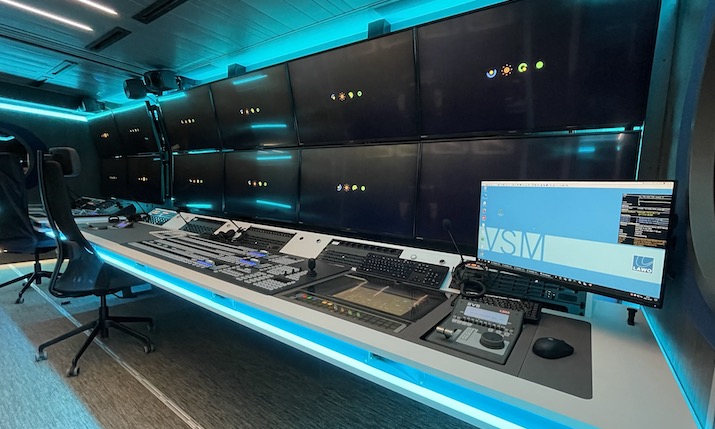Studio Berlin opts for Lawo mc² consoles and VSM in new Ü10 truck

German TV production service provider Studio Berlin is using Lawo mixing consoles and control systems in its new UHD HDR OB, Ü10, which will be used mainly for production of the Bundesliga.
Audio control rooms 1 and 2 of the new van are equipped with an mc²56 production console and an mc²36 all-in-one console, respectively, powered by fully redundant A__UHD mixing cores and a Lawo VSM broadcast control system. Each stand-alone core delivers 1,024 channels of audio processing (48/96kHz) and offers numerous monitoring options as well as downmixing and upmixing. A__UHD technology is based on open AoIP standards such as ST2110-30/-31 and AES67/Ravenna, and utilise Ember+ and NMOS for control. For large productions, the vehicle can access up to eight video and audio stage boxes.
“As part of our new OB van build, we were faced with the decision of which audio system to use,” said Mathias Heinrich of Studio Berlin, sound engineer for Ü10. “We wanted forward-looking IP technology, and we have always relied on Lawo for audio processing and mixing, so only A__line AoIP nodes combined with a new mc²56 MKIII or an mc²96 came into consideration. Due to the space limitations of an OB van, we opted for the mc²56 console.”
Audio control room 1 uses a 64-fader mc²56 MKIII audio production console, which has native support for SMPTE 2110, AES67/Ravenna and MADI audio streams. In addition to multi-user operation, AutoMix, upmix, downmix and Lawo Kick, the console includes audio-follows-video functionality, integrated 3D/immersive mixing tools and parallel compression. Thanks to Lawo’s IP Easy functionality (which is based on the Home management platform for IP broadcast infrastructures and features automatic detection and quarantine routines), IP setup is as easy as analogue.
Audio control room 2 is equipped with a 16-fader Lawo mc²36. Its built-in A__UHD core technology provides 256 processing channels (48/96kHz), local I/O, 864 channels and integrates with solutions such as Waves SuperRack SoundGrid. It also supports ST-2110, AES67, Ravenna and Ember+. The mc²36 also offers IP network management based on Lawo’s Home platform.
“Due to the structured surface of the Lawo consoles and their peripherals, a seamless transition with almost unchanged operation is possible despite the technology change to ST-2110 AES67/Ravenna,” said Heinrich. “The Lawo audio infrastructure combines to make a high-performance system that we believe can cope with almost any large-scale production. The Ü10 was conceived and built with major sports productions and show events in mind, and is therefore equipped to handle any imaginable production.”
The Ü10 allows productions with up to 24 UHD cameras, plus additional wireless cameras. It is equipped with a Grass Valley 12G K-Frame XP Compact vision mixer with Xtreme option. Two Grass Valley control panels, a Karrera K-Frame 3 M/E in the main control room and a Korona 2 M/E in the second control room, access the image mixer. For the router, Studio Berlin chose the decentralised MediorNet solution from Riedel, which manages the video and audio signals as well as the multiviewers.
All of this production technology is controlled by VSM (Virtual Studio Manager) from Lawo. This manufacturer-agnostic system controls all video/audio routers and mixers, intercoms, UMDs and multiviewers, ‘glue’, and other third-party baseband and IP devices.
“Using VSM, we can quickly route individual intercom ports from Riedel to the MADI streams of the Micron UHD cores and the AES ports of the A__stage80 audio stageboxes at the touch of a button,” added Heinrich. “The fully redundant VSM system is the only sensible solution for us to be able to work in a clearly structured and, above all, fast and efficient way, not only in the intercom area, but also for the wiring of transmission lines, monitors, de-embedders, and all other video and audio signals.”
The ability to create pseudo-devices within VSM makes it possible for the whole team to work virtually. This ’embedded workflow’ conserves physical resources such as MADI streams or AES paths, which provides freedom and flexibility elsewhere.
Heinrich said: “Two Lawo V__pro8 units were installed for additional embedding and de-embedding, which enables us to quickly and easily shift times in terms of an audio/video offset. Any Dolby alignment is a piece of cake with this.”
Planning and construction of the vehicle was carried out by German system integrator Broadcast Solutions.
